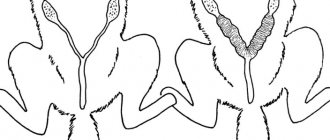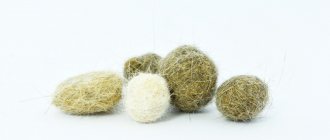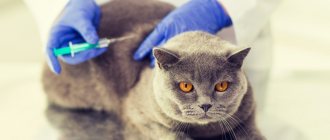Save the article:
Sometimes the owner, showing affection to his furry pet, notices that real dandruff has appeared in the cat’s fur. For many, this will be an unpleasant surprise, especially if the animal’s hygiene is observed according to all the rules. Dandruff in a cat looks the same as in humans - the top layer of skin gradually dies, and the scales flake off from the surface of the skin at a certain speed. Sometimes it happens that an excessive amount of dead cells is formed, then white skin particles appear on the fur, and the pet’s appearance becomes unkempt.
Pathogens and causes of the disease
The causative agent of the disease is mites of the genus Cheyletiella, which spend their entire life cycle on the host, or more precisely, on his skin.
It is here that cheyletiella undergoes six stages of development:
- The fertilized eggs laid by the female are secured by the female to the animal's hair using thin silky threads, forming a kind of cocoon.
- After an incubation period of 3-4 days, six-legged larvae are born.
- After 7.5 days they turn into protonymphs, but with 8 legs.
- After another 4-5 days, the protonymphs turn into 8-legged deutonymphs.
- After another 5 days, the deutonymphs enter the adult stage.
- They then develop into adult ticks, females and males that are whitish-yellowish in color and live for about 14 days.
Thus, the complete life cycle of the parasite fits into the period of 21-35 days. However, it should be remembered that adult ticks are capable of existing outside the host: in females, the period of autonomous existence is up to 10 days, in males – up to two days.
Mites live on the surface of the skin, without going deep into the epidermis. They feed on tissue fluid, to obtain which they make punctures with chelicerae - a kind of claw-like appendage.
Cheyletiellosis is a highly contagious disease that is instantly transmitted from an infected animal to a healthy one. Its danger also lies in the fact that in some cases no external characteristic signs are noticeable on an infected animal, but it is capable of infecting everyone with whom it comes into contact.
We should also not forget that adult ticks can exist autonomously, that is, without a host, for quite a long time, and when a suitable object appears, they immediately settle on it.
Description
Cheyletiellosis is one of the diseases that are easily transmitted from sick animals to healthy ones. In addition to cats, the disease affects representatives of dog breeds, guinea pigs, hamsters, and rabbits. Moreover, each type of pathogen lives on the skin of a specific animal species.
Cheyletiellosis poses a danger to humans. The causative agent of the disease can temporarily live on his body, causing the appearance of an itchy rash, small erythematous papules on the arms and torso. According to doctors, owners of sick cats become infected in 30% of cases.
Basically, cheyletiellosis is accompanied by moderately severe symptoms and may have common features with manifestations of allergies. Adult animals often tolerate it without obvious signs or severe deterioration in health. It is quite difficult for young and elderly pets.
Being asymptomatic, the disease does not become less dangerous and is instantly transmitted from the carrier to others. Its spread is activated under poor conditions for keeping pets and overcrowding of animals.
Independent attempts to cure a cat often end in vain. If signs of pathology appear, it is mandatory to contact a veterinarian
Symptoms and manifestation
English veterinarians gave cheyletiellosis the name “wandering dandruff,” which quite accurately characterizes its external manifestations.
Visual symptoms of the disease are expressed in the movement of pieces of dry epidermis, which looks like the movement of dandruff. If you look closely at infected animals, then with the help of a regular magnifying glass you can see the ticks themselves in these areas of the epidermis (see photo below).
Diagnostics, paradoxically, is difficult precisely in well-groomed animals, which the owners regularly treat with appropriate medications, wash, etc.
Currently, there is no absolutely accurate method for establishing a diagnosis; all the more, differential diagnosis with diseases such as seborrhea, dermatitis of other etiologies, food allergies, etc. is necessary.
The main symptom is severe peeling of the skin, as a result of which dandruff forms in large quantities in dogs, as well as in cats.
The same can be observed in the rabbit. This process occurs even more actively in puppies from 2 to 8 weeks - it seems that they are covered with a continuous scaly film.
Along with profuse dandruff formation, sick animals may experience:
- alopecia, that is, hair loss;
- increased oily skin and coat;
- ruffled fur;
- the appearance of erythema (redness of the skin), hyperemia, inflammation of the skin;
- skin hyperpigmentation and scaliness;
- pruritus - skin itching, forcing animals to scratch their skin all the time;
- the appearance of papules and pustules on the skin;
- the appearance of ulcers, erosions, excoriation (scratching) on the skin.
The latter is especially dangerous, as it opens the door to infection. However, the deeper layers of the skin are usually not damaged.
In cats, a characteristic symptom of cheyletiellosis is that they begin to lick their fur more intensively; They often develop bilateral alopecia, located symmetrically.
In many ways, the manifestations of the disease are determined by the individual characteristics of the animal: sometimes the itching can be very strong, and sometimes it can be completely absent.
Long-haired cats and dog breeds such as cocker spaniels and poodles usually show no symptoms of the disease, and it is often diagnosed only after the owner develops an itchy papular rash.
In any case, even in the absence of itching, if the animal's skin is actively peeling, it is necessary to check it for the presence of mites that cause cheyletiellosis.
What is cheyletiosis
This is a pathology in which the skin is damaged. It is caused by the mite Cheyletiella Yasguri. It is an obligate parasite that lives on the surface of the dermis. It is very small, has a light, slightly yellowish body. The female attaches eggs to the dog's fur almost at its very base using a special sticky secretion. The larvae emerge from the eggs after 10-15 days, molt repeatedly, and after 25-30 days they become sexually mature ticks. They feed on subcutaneous fluid. In the external environment without a host, these parasites can live up to 10 days. During this period they are potentially dangerous to animals.
How is cheyletiellosis transmitted?
What doctors say about treating parasites
Doctor of Medical Sciences, Professor German Shaevich Gandelman
Work experience: more than 30 years.
I have been detecting and treating parasites for many years. I can say with confidence that almost everyone is infected with parasites. It's just that most of them are extremely difficult to detect. They can be anywhere - in the blood, intestines, lungs, heart, brain.
Parasites literally devour you from the inside, at the same time poisoning your body. As a result, numerous health problems appear, shortening life by 15-25 years.
The main mistake is delaying! The sooner you start removing parasites, the better. If we talk about medications, then everything is problematic. Today there is only one truly effective anti-parasitic complex, this is TOXIMIN. It destroys and sweeps out all known parasites from the body - from the brain and heart to the liver and intestines. None of the drugs existing today is capable of this.
Within the framework of the Federal program, when submitting an application before June 10. (inclusive) every resident of the Russian Federation and the CIS can receive one package of TOXIMIN FOR FREE!
As already mentioned, the main source of infection is contact with a sick animal or even simply with the place where it recently visited and where ticks could remain (bedding, combs, toys, etc.).
Cheyletiellosis occurs in all breeds of dogs, but lap dogs, poodles and Yorkshire terriers are most susceptible to it, and among cats - representatives of long-haired breeds, as well as young dogs and cats and individuals with weak immunity and reduced skin resistance.
The disease spreads especially quickly in crowded conditions of animals, in poor zoohygienic conditions, which sometimes exist in nurseries and animal hotels. You can even get infected in grooming salons.
Flies, lice, fleas, and even humans can act as carriers of ticks if a tick attaches itself to them.
As for humans, cheyletiellosis manifests itself in the form of severely itchy rashes, scattered or grouped on those areas of the skin that have been in contact with an infected animal. In place of red papules, blisters, pustules and even necrosis can form.
Infection with scabies mites
Feline demodicosis is a chronic parasitic skin disease in cats caused by the microscopic worm-like mite Demodex cati.
The causative agent of demodicosis, being itself an endoparasite, is localized in the hair follicles and sebaceous glands. It is half a millimeter long and has a transparent body with poorly defined boundaries between the cephalothorax and abdomen. It has short legs with hooks at the ends. The oral apparatus is equipped with a gnawing type proboscis.
Demodicosis in cats occurs in three forms.
Scaly form. This form is the mildest form of demodicosis and is most often found in young cats (up to 2 years old). Symptomatically, this form is manifested by itching, focal lesions on the skin, the number of focal zones does not exceed five, redness, dry scales appear on the cat’s ears, eyelids and neck. However, there are no signs of skin lesions on the cat’s paws and back.
Generalized form. In this form, the disease occurs with massive damage to the skin and is accompanied by the formation of pustules, bleeding wounds, the affected skin is severely flaky, the cat's owners note constant itching, erythema, scratching, and scabs appear. At the location of the tick itself, upon careful examination, we note small elevations, with a crater in the middle, from which, when pressed, a white mass emerges.
Juvenile demodicosis. In terms of its clinical manifestation, this form of demodicosis is practically no different from the generalized form. The only difference is that juvenile demodicosis in cats is a genetic disease (the kitten is infected in the womb). This form of demodicosis is the most severe for a cat, due to the fact that it causes consistent damage to the cat’s immune system, as well as the entire body.
Additional information about the disease is presented in the article – Demodicosis in cats.
Notoedrosis (pruritic scabies) is a chronic invasive disease of cats, clinically accompanied by dermatitis in the scalp, itching, scratching and hair loss.
The source of infection is animals with notoedrosis, especially stray cats, dogs, rabbits, as well as rats and mice, which cats are especially fond of. Transmission of the infestation pathogen to a cat occurs through direct contact with an infected animal or through infested care items.
Penetrating into the thickness of the epidermis, itching irritates the nerve endings and injures the basement membrane of the epidermis, as a result of which the papillary and deeper layers of the skin are involved in the inflammatory process. All this causes disturbances in the central nervous, cardiovascular and reticuloendothelial systems.
Clinical picture. Notoedrosis lesions in cats initially appear on the scalp (on the bridge of the nose, brow ridges, at the base of the ears) in the form of papules and vesicles, which then become crusted. A sick cat develops itching, which is especially intensified in the evening. On clinical examination of such cats, the skin appears dry, thickened, crusty, and dermatitis and hair loss are noted.
Such a cat suffers, becomes weak and, upon external examination, looks unhappy. If untreated, the disease process spreads from the head to the back, shoulder blades, paws of the hind and forelimbs. The generalized form of notohedrosis in cats usually develops after 2-3 months. The cat loses weight, the skin becomes folded and becomes covered with dry, gray crusts.
More details about the disease in our article – Notoedrosis (pruritic scabies) in cats.
Otodectosis or ear scabies is a chronic invasive disease of cats caused by parasitic otodectosis mites on the inner surface of the ears and in the external auditory canal.
Young animals aged from 1.5 to 12 months are most often affected. Otodectosis has no seasonality; a cat can become infected at any time of the year, but more often infection occurs in the warm season because... The parasite persists longer in the external environment. A cat becomes infected from an animal with ear scabies through direct contact; people can carry mites through grooming items.
At the beginning of the disease, the sick animal experiences mild itching, the sick cat begins to worry, shakes its head, tries to comb the mite-affected ear with the claws of its paws, or scratch the sore ear on various objects. During a clinical examination of such a sick cat, the veterinarian detects inflammation of the ear canal; serous and sometimes purulent and ichorous exudate is released from the ear canal, which has a sharp putrefactive odor.
We suggest you read: How to treat cucumbers against spider mites in a greenhouse
Sometimes the exudate completely clogs the ear canal and this leads to hearing loss. The exudate released from the ear canal glues the hair of the lower edge of the auricle and, when dried, forms scabs and crusts of gray or light brown color. Sometimes if you lightly press on the base of the ear, you can hear a characteristic splashing sound.
Additional information about the disease can be found in our article – Otodectosis in cats.
Treatment options
It is possible to determine how to treat this disease only after differential diagnosis. Simultaneous treatment of all animals kept in the house or nursery should be carried out.
It is also necessary to actively disinfect the space surrounding them to avoid re-infection and latent carriage. For ease of processing, it is recommended to cut long-haired dogs and cats as short as possible.
The treatment is quite long - from 6 to 8 weeks. The fact is that any drugs effectively affect only adult ticks, and at all other stages of development the drugs are useless, so only a long course can interrupt the life cycle of this parasite.
The following drugs are recommended:
- for dogs - pyrethrins or organophosphorus compounds;
- for cats of any age, puppies and rabbits - solutions of sulfonated lime and pyrethrins.
Cause and route of infection
The cause of such an unpleasant external disease is the microscopic mite Cheyletiella. This is a genus that can live for a long time on dogs, cats or rabbits. A person can also be infected, but this happens only in 30% of cases, since people are far from the best hosts for them. Heylitela is distinguished from its fellow creatures by powerful parts of the oral apparatus, more like claws. They can only be seen in photographs taken with high magnification.
The main route of infection is contact. However, the disease is not always transmitted directly from the carrier to the infected person. The insects are able to survive for a week in the environment. Therefore, you can catch cheyletiosis by being in a room where a sick dog was, or by using its things.
Very often, adult dogs are carriers of the infection, but the disease does not appear on them outwardly. This allows them to infect a large number of surrounding four-legged fellows, while even the dog owner will not know that his pet is an insect carrier.
It is possible to defeat parasites!
Tips from our readers
I got rid of parasites in just a week! I was helped by a remedy that I learned about from an interview with a parasitologist.
Toximin® - a remedy for parasites for children and adults!
- Dispensed without a doctor's prescription;
- Can be used at home;
- Clears parasites in 1 course;
- Thanks to tannins, it heals and protects the liver, heart, lungs, stomach, and skin from parasites;
- Eliminates rotting in the intestines, neutralizes parasite eggs thanks to the F molecule.
A certified remedy recommended by helminthologists for getting rid of parasites at home. It has a pleasant taste that children will like. Consists exclusively of medicinal plants collected in environmentally friendly places.
There is a discount now. The drug can be obtained free of charge.
Hello, readers of the site about parasites Noparasites.ru. My name is Alexander Lignum. I am the author of this site. I am 23 years old, I am a 5th year student at the Kemerovo State Medical Institute. Specialization "Parasitologist". Consultation by phone: +7. More about the author>>
The best stories from our readers
Topic: Parasites are to blame for all troubles!
From: Lyudmila S. ( [email protected] )
To: Administration Noparasites.ru
I have felt very bad for the past few years. Constant fatigue, insomnia, some kind of apathy, laziness, frequent headaches. I also had problems with digestion, and in the morning I had bad breath.
And here is my story
All this began to accumulate and I realized that I was moving in some wrong direction. I began to lead a healthy lifestyle and eat right, but this did not affect my well-being. The doctors couldn’t really say anything either. Everything seems to be normal, but I feel like my body is not healthy.
Then I went to an expensive clinic and had all the tests done, and in one of the tests I was found to have parasites. These were not ordinary worms, but a specific type, with which, according to doctors, almost everyone is infected, to a greater or lesser extent. It is almost impossible to remove them from the body. I took a course of antiparasitic medications that were prescribed to me at that clinic, but there was almost no result.
A couple of weeks later I came across an article on the Internet. This article literally changed my life. I did everything as it was written there and within a few days I felt significant improvements in my body. I began to get enough sleep much faster, and the energy that I had in my youth appeared. My head no longer hurts, my mind became clearer, my brain began to work much better. My digestion has improved, despite the fact that I now eat haphazardly. I took tests and made sure that no one else lives in me!
Anyone who wants to cleanse their body of parasites, no matter what types of these creatures live in you, read this article, I’m 100% sure it will help you! Go to article>>>
The process of peeling off the top layer of keratinized skin occurs constantly, due to the renewal of the epidermis. Excessive accumulation of “scales” on the skin of an animal is called dandruff. Dandruff is a symptom of a pathological condition caused by disruption of the sebaceous glands and characterized by an increase in the rate of detachment of skin particles in the form of scales over a long period of time. The scientific name of this disease is seborrhea. It affects kittens and adult cats of all breeds, regardless of gender.
In the article we will tell you why dandruff appears, what to do when it is detected, how to cure seborrhea by going to the doctor and at home, as well as possible complications of the disease and preventive measures.
Main features
Signs of seborrhea in a cat:
- excessively oily skin under the coat;
- excessive amount of white “scales” of keratinized skin;
- inflammation (redness) of the skin;
- presence of itching.
There are three types of seborrhea:
- dry: “scales” of skin fall off when stroking the fur;
- oily: dandruff does not fall off when combed, the “scales” are glued together;
- mixed type.
Causes of dandruff
There are external and internal causes of the disease.
External ones include:
- Low level of air humidity. Dry air negatively affects the skin of the animal, the skin becomes thick and dry, and dandruff appears. Often accompanied by the appearance of cracks on the paw pads.
- Lack of proper care for the cat's fur and its place of residence, unsanitary conditions. In this regard, fleas, lice and other parasites appear and actively reproduce, causing irritation and itching of the skin. Dandruff can be caused by mites if the animal walks outside.
- The effects of cosmetics and cleaning products on animal fur.
Important! Using shampoo intended for humans may cause allergic reactions on your pet's skin.
- Improper combing of fur. Leads to irritation, scratches and microtraumas of the animal’s skin, which leads to accelerated skin regeneration and the appearance of “scales”.
- Sunburn or excess ultraviolet rays. They lead to accelerated death of epidermal cells and, accordingly, the appearance of dandruff.
- Stressful situations. For example: sterilization, moving to a new place, bringing another pet or child into the house.
- Frequent contact with water. Constant wetting of the skin causes irritation and drying out of the upper layer of the epidermis.
Internal factors:
- Incorrectly formulated diet. It entails a lot of health problems, such as:
- Obesity. If an animal is overweight, it is difficult to care for itself, reaching the back and lumbar area, which is why excess dandruff accumulates in these places.
- Allergic reactions.
Carefully! Allergies can be caused not only by food, but also by chemicals in finished food.
- Problems with the digestive system. They lead to metabolic disorders in the body, which affects the appearance of the cat.
- Vitamin deficiency or excess vitamins. For example, when there is a lack of vitamins A and B in the body, or when there is an excess of them, seborrhea appears.
- Bacterial or fungal diseases. For example, microsporia or lichen lead to skin irritation, constant itching and hair loss in the affected areas.
- Hormonal disorders (hypothyroidism, sex hormone imbalance, Cushing's syndrome). Disturbed metabolism associated with the functioning of the thyroid gland leads to seborrhea.
- Diseases of the musculoskeletal system (arthritis, arthrosis). Pain in the joints when moving prevents the cat from grooming the rump and tail areas, which leads to excessive deposits of “scales” on the skin in these areas.
- Diabetes. A disease associated with insufficient production of the hormone insulin and leading to metabolic disorders, which also affects the animal’s skin.
- Diseases of the urinary system.
- Seborrhea of idiopathic form. This is a hereditary disease characterized by the active secretion of sebum.
- Side effect from drug treatment. Skin reactions occur to medicated shampoo or to taking medications.
How to prevent seborrhea
Try to help your pet get rid of the disease yourself using the following methods:
- carry out antiparasitic treatment at home;
- check the air humidity level, you may need a humidifier;
Bathing a cat to treat dandruff
Important! If after carrying out all the above measures the disease progresses, contact your veterinarian.
Prepare in advance the answers to the questions that the doctor will ask you at the appointment to make the correct diagnosis. List of sample questions:
- What is the cat’s diet (main products, diet, amount of food).
- Basic habits and behavioral characteristics of the pet (for example, does it like to lie in the sun, which can cause sunburn).
- How well are hygiene rules observed at home?
- What products and how often do you use when bathing your pet and cleaning the house?
- What vitamin supplements do you give?
- Where and in what conditions does the cat live?
- What was or is you sick with? What medications were used for treatment.
- How do you care for your fur?
After collecting anamnesis, the doctor will prescribe the following tests:
- general blood test and biochemistry;
- blood test for hormones;
- skin scraping;
- inoculation on a nutrient medium and identification of skin culture;
- skin biopsy.
How to find the reason
It is very important to quickly determine the cause of your cat's frequent scratching. The sooner this can be done, the sooner appropriate treatment can begin. A veterinarian must figure out the cause, and it is good if the animal owner can provide assistance to the specialist. For example, it will answer the questions:
- when did the first signs of a problem appear;
- whether the sudden habit of scratching is accompanied by other symptoms;
- how the animal’s behavior has changed;
- what does a cat eat?
- whether there was any seasonality in symptoms;
- how often does the pet go outside?
- Does he have contact with other animals, etc.
The timing of diagnosis and the promptness of prescribing adequate treatment depend on the accuracy of the answers.
Treatment of seborrhea
Treatment of seborrhea is prescribed comprehensively, it includes:
- prescription of medications;
- changing the diet and composition of food;
- prescription of vitamins (Sherstevit, Phytomins VEDA, Farmavit NEO, Beaphar and others) and food additives containing Omega-3 fatty acids;
- prescribing a course of antifungal therapy and antibiotics for fungal and bacterial infections, as well as retinoids;
- improving the sanitary condition of the room where the cat lives;
- changing the care of the animal's fur;
- use of medicated shampoos;
- use of folk remedies;
- skin massage and proper combing of the coat.
Carefully! At home, treatment of seborrhea can be carried out after consulting a doctor, prescribing special detergents and permission to use traditional medicine.
Effective shampoos for seborrhea include:
- Antifungal and antiseborrheic: “Doctor”, “Veterinary Formula Clinical Care”, “Tea Tree”, SynergyLabs Veterinary Formula Antiseptic & Antifungal, Anju Beauté.
- For fleas and parasites: “Clandestine”, “Bayer Adventage 80”, “Beaphar”, “Fiprex”.
- For ectoparasites: "Lufenuron Oral Suspension For Cats".
- To normalize the functioning of the sebaceous glands: “Biovax”
Such shampoos, in a certain dosage, contain substances that can fight the disease and its consequences, for example:
- chlorhexine (antibacterial effect);
- zinc (skin regeneration and healing);
- salicylic acid (exfoliation of dead epithelial cells, healing of the skin);
- vinegar (fights infections, has an antibacterial effect);
- olive, burdock or calendula oils (promote softening and renewal);
- herbs: string, chamomile, burdock (relieves itching, irritation, restores epithelium).
It is dangerous to practice many of these ingredients on your own to treat seborrhea without consulting your doctor; you need to know the correct dosage, frequency and duration of their use.
Treatment at home
There are traditional medicine remedies and recipes that your doctor will most likely allow you to use to fight the disease at home:
- Bathing the pet once every 2 months with a special shampoo, massaging the skin and combing the skin during the procedure. Actions during and after washing:
- for dry seborrhea, use moisturizers in the form of oils added to water (urea, propylene glycol, sodium lactate, lactic acid);
- in case of oily seborrhea, in case of severe course and complications of the disease with dermatitis, remove the hair from the pet’s skin, then use bandages with ethyl alcohol for disinfection, treat the skin with Engystol to eliminate inflammation and itching. In addition, for this type of disease, products are used that degrease and dry excessively oily skin (sulfur compounds 0.5-2%, salicylic acid 0.5-2%, selenium sulfide, benzoyl peroxide).
Treatment
After confirming the diagnosis of cheyletiellosis, the veterinarian immediately begins treating the animal using effective antiparasitic drugs. To make it easier to treat problem areas of the skin, cats with long hair are trimmed.
Owners of infected pets will need to consider several points:
- If there are other animals in the house besides the cat, all of them should also be treated with antiparasitic drugs. If this rule is not followed, after some time the tick will become active again.
- It is necessary to thoroughly sanitize the entire room where the infected cat and its owners live. The pet's accessories, bedding, trays, and toys must be treated. You will need to vacuum up wool and dander from the floors, thoroughly wash and wash all bedding, capes, and treat upholstered furniture.
- Treatment takes six to eight weeks and ensures complete elimination of mites in various stages of development. All this time, the cat will need to be bathed regularly, helping to constantly cleanse the skin of parasites. Treatment of pathological areas of the epidermis is carried out only after thorough washing.
It is important to remember that the Cheyletiella blakei tick has considerable resilience, and fighting it will require long-term efforts from the animal’s owners. To successfully defeat the parasite and get rid of it forever, you must carefully follow all the recommendations of your doctor.
First aid
If your cat shows signs of developing cheyletiellosis, it is recommended to avoid uncontrolled use of medications and immediately visit a veterinarian. Before starting the treatment course, it is necessary to isolate the pet. This will help stop the rapid spread of parasites and prevent infection of healthy animals and people.
Folk remedies are used as first aid - bathing in decoctions of wormwood, coltsfoot, burdock, St. John's wort. Such procedures will help temporarily reduce itching and briefly improve the patient’s well-being.
The listed compositions are auxiliary and are never used as the main methods of combating pathogenic mites.
Basic treatment
When cheyletiellosis develops in a cat, the use of potent veterinary drugs intended for application to the skin becomes mandatory:
- Butox;
- Acaromectin;
- Demos;
- Barça;
- Ivermec spray.
With the listed medications, two or three treatments of the epidermis are carried out, between which a two-week interval is maintained. Pets are often prescribed the tablet drug Ivermectin internally. In case of a generalized form of the disease, subcutaneous injections with Ivermek are performed.
To enhance the effect of veterinary drugs, powders with sulfur are used. Vitamin and mineral complexes for cats containing biotin help speed up the restoration of damaged epidermis and fur.
Thorough cleaning with chlorine-containing products helps destroy ticks in the room. Also for this purpose, the use of insecto-acaricides is indicated.
After the animal has fully recovered, the condition of its owners improves, and the rashes on the skin of people disappear within a few weeks.
Complications
Complications of seborrhea may be the following:
- Purulent dermatitis. Occurs in the area affected by seborrhea due to the layering of bacterial flora, usually located on the upper layer of the epithelium and does not cause reactions. Ulcerations form, itching intensifies, and the skin becomes very red.
- Eczema. Redness and itching of the affected area after scratching becomes covered with papules (nodules), in place of which vesicles (bubbles) with liquid appear. Pyogenic bacteria enter places with opened blisters, the wounds become infected and ulcers, ulcers and erosions appear. The skin is constantly inflamed, swollen, raw, and the animal is in pain.
Prevention
Disease prevention measures include:
- Ventilate the room and provide sufficient air humidification.
Omega-3 fats to prevent dandruff
To avoid serious consequences for your pet’s health, carefully monitor its condition and lifestyle, provide proper care and optimal living conditions, and do not neglect contacting an experienced veterinarian at the slightest sign of illness.
Dandruff or seborrhea
- this is, in general, not dangerous for the animal’s body, but an unpleasant phenomenon in which the upper scaly layer of skin begins to rapidly die and peel off, creating “artificial snow” on the cat’s fur and thereby spoiling its appearance.
Most often, dandruff can be seen on a cat's back; most of it accumulates on the back at the base of the tail and on the tail itself.
Types of dandruff in cats
Depending on the causes of seborrhea and the individual characteristics of the cat’s body, dandruff can be dry or oily. And also differ in color; dandruff can be white or black.
White dandruff in a cat
Externally, dry dander looks like fine white flour and easily falls off into “snowflakes” if you run your palm against the animal’s fur. Sometimes, owners of cats with dark fur notice black dandruff on their pets and think that this is a normal phenomenon. However, it is not.
Dark (black) dandruff on a cat’s fur is proof that the animal’s skin is infected with fungus or all kinds of parasites.
Oily dandruff
has a different consistency: it can be either liquid or thick. If you notice hairs stuck together behind your cat's ears, on her back, or around the base of her tail, this is most likely oily dandruff.
With such seborrhea, the hair feels wet, greasy to the touch, hangs in “icicles” and visually looks heavy. The palm, after stroking a cat suffering from oily seborrhea, begins to shine and become shiny.
If seborrhea is thick, it is not easy to detect immediately. However, if, after scratching the animal behind the ear, you find oily skin flakes under your nails or feel low sticky bumps under the cat’s fur, then this is a clear sign of thick, oily dandruff. In this case, the particles of dead skin are not small grains, but rather large layers stuck together.
Diagnostics
If characteristic signs of a parasitic disease appear, the dog should be shown to a specialist. The diagnosis is made based on a physical examination as well as the results of microscopic analysis. A scraping of the animal's dermis is taken and placed on a glass slide. Cheyletiella can be detected using 50% glycerol. Scraping is not necessary. Mites can be found on the surface of the skin. They are also clearly visible on dark paper if you brush dandruff from the fur onto it.
Cheyletiellosis must be differentiated from other diseases:
- pyoderma;
- allergy;
- seborrhea;
- demodicosis;
- sarcoptic mange;
- lice or lice.
Causes of dandruff in cats
1 The most common reason for the development of seborrhea is fungi
. Microscopic organisms, getting on the skin and fur of a cat, lead to the appearance of fungal diseases, which, in turn, lead to intense death of skin cells and their peeling.
2 Such parasites
, like ticks, fleas, and various lice-eaters, are also the causative agents of dandruff. Their waste products (saliva, excrement) irritate the skin and lead to the death of its surface epithelium. In addition, the bites of these parasites cause unbearable itching, and the cat begins to scratch the skin, thereby accelerating its exfoliation.
3 Improper metabolism in the animal’s body is another reason for the development of seborrhea. An unbalanced diet and insufficient fatty acids in cat food can lead to metabolic disorders, and this can cause seborrhea.
4 Allergens
, contained in cat food, dust, pollen, gases, can cause allergic reactions and cause dandruff.
5 Overweight cat
. It is difficult for overfed cats to take care of themselves, they become clumsy and lazy, and therefore, due to the lack of proper hygiene, dandruff may occur.
6 Poor nutrition or change of food
It can also cause dandruff in cats. Cheap food, oversaturated with carbohydrates, feeding a cat human food from the table - all this can also lead to dandruff.
7 Poor or too “good” care for your pet
- This is a common cause of seborrhea. So, if you don’t take care of your animal’s fur, don’t spend enough time examining it, and neglect to use antiparasitic medications, then dandruff can appear at any time.
Or, on the contrary, you bathe your pet too often or comb it unnecessarily, then such caring “measures” of yours will cause the development of seborrhea.
Each individual cat's reaction to shampoo or other bathing product is strictly individual. Frequent combing of the fur is accompanied by a certain irritation of the skin and this also accelerates the death of its surface layer and loss in the form of dandruff.
There are other causes of dandruff:
- disturbances in the functioning of the digestive system,
- skin diseases,
- diseases of the gastrointestinal tract,
- increased dryness of indoor air,
- stress,
- taking medications,
- hormonal imbalances, etc.
Signs and symptoms
The causative agents of Cheyletillosis are localized on the surface of the dermis. They pierce it, thereby causing severe itching in the dog. She has to itch all the time. The favorite habitats of insects are the dorsal part of the neck and the body along the back. If you move the fur apart, you can see a large number of transparent scales at the base. Outwardly, they look like large dandruff or bran (hence another name for the disease “pityriasis scabies”).
The affected skin itself is hyperemic. Papules and pustules appear and become covered with dark crusts. Dirt, blood, and dead skin cells gradually stick to them. They become gray-yellow and oily. Among the crusts you can see light scales with a cluster of mites.
On a note! If therapeutic measures are not taken in a timely manner and the dog continues to scratch problem areas, the pathological process will progress and the affected area will increase. When the integrity of the skin is violated, a path is opened for pathogenic microflora to enter. This leads to purulent processes, the development of severe dermatitis and eczema. Subsequently, the dog may develop cachexia, which is fatal to the animal.
Diagnosis of the disease
If you notice the first signs of the onset of seborrhea, you should contact a veterinary clinic. To make a correct diagnosis, the doctor will first collect an anamnesis about the animal (previous illnesses, find out about the cosmetics used, antiparasitic drugs used, etc.), and then take all the necessary tests:
- blood test, its biochemistry,
- hormonal analysis,
- scrapings,
- skin cytology,
- bacterial crops,
- skin biopsy.
If the research does not reveal a chronic disease, then treatment will consist of recommendations for replacing cosmetics and changing the cat’s diet.
In nutrition
For cats, it is important to exclude fatty and sweet foods, and also add professional food containing vitamins A, B, Omega-3 and 6.
You can use professional medicated food:
For more information about food, read our article: Review of the TOP 15 best food.
How to cure dandruff in a cat?
It is not always possible to visit a veterinary clinic or call a specialist at home.
If dandruff in a cat is treated not under the supervision of a doctor, but at home, then there are several proven and reliable ways to rid your pet of dandruff.
When bathing cats, use decoctions of burdock, nettle or calendula. Also suitable are decoctions of calamus, sea buckthorn and coltsfoot berries.
Massaging the cat's skin while brushing helps. Massage stimulates blood flow and thereby speeds up skin restoration.
Medicinal anti-dandruff shampoos for cats
Below we list the most common anti-dandruff shampoos for animals, which are recommended by veterinarians, and their cost:
Anti-Dandruff
from Beaphar (Biafar)
is a medicated anti-dandruff shampoo for dogs and cats.
Dandruff by GlobalVet
– medicated anti-dandruff shampoo for dogs, cats, ferrets.
Shampoo "Doctor"
- used for the treatment of skin diseases in cats and dogs: demodicosis, sarcoptic mange, superficial and deep dermatitis, folliculitis, pododermatitis, seborrhea (dandruff).
CitoDerm (Cytoderm)
– anti-dandruff shampoo for cats and dogs.
Tar from Animal Play
– shampoo for cats and dogs against dandruff and itching.
Dry shampoos (no rinse):
Tropiclean
(Tropiclin) - dry anti-dandruff shampoo for cats without rinsing.
Dermatomycoses
Dermatomycosis occurs in cats as a result of damage to the integrity of the skin and the penetration of bacteria or fungi into the skin (microsporia, trichophytosis, ringworm in cats, dermatophytosis). Inflammation develops quite quickly and can occupy large areas of the skin. Inflammation of the skin in a cat is most often accompanied by pustules (pyoderma) or weeping wounds (streptococcosis of dogs and cats).
Cats become infected from animals or care items infected with these diseases. Often the distributors of these diseases are rodents (rats, mice).
We suggest you read: Effective deworming medications for cats and dogs
Ringworm is a highly contagious, anthropozoonotic disease of humans and animals, including cats, caused by microscopic fungi of the genus Microsporidium and Trichophyton. Ringworm in cats is accompanied by the formation of hairless areas on the cat's body, peeling, redness and itching of the area affected by the fungus.
A cat becomes infected with ringworm when fungal spores land on damaged areas of the skin. Sick animals with scales and fur release a huge amount of fungal spores into the external environment, which can retain their pathogenic properties for a long time (up to 10 years). A cat can become infected with ringworm through fungal-infected grooming items, bedding, water, and so on.
In the external environment, infected soil and grass serve as a permanent reservoir of pathogenic fungi. In large cities, stray cats, rats, mice and various ectoparasites (ticks, fleas) play a large role in the transmission and possibility of infection with ringworm. Ringworm primarily affects cats under one year of age.
The diagnosis of ringworm is made in a veterinary clinic based on the clinical picture of the disease and the results of laboratory testing of affected areas of skin that have not been treated. In a veterinary laboratory, pathological material is examined under a microscope and then inoculated onto special nutrient media.
Treatment. Ringworm involves isolating a sick cat in a separate room, which must be periodically ventilated and periodically wet cleaned with disinfectants. Treatment depends on the severity of the disease, the number of affected areas and the state of the body's immune system.
At the onset of the disease, veterinary specialists receive good results from the use of therapeutic and preventive vaccines. In the case when a cat has damage to large areas of the skin, antifungal drugs are used (Griseofulvit, Dermicotsid - produced in the form of solutions in ampoules of 5 ml, administered in a dose of 1-2 ml into the thigh area 2-3 times with an interval of 3-3 5 days). In case of a generalized process, these drugs are used both externally and internally.
For more information about this disease, see the article - ringworm in cats.










